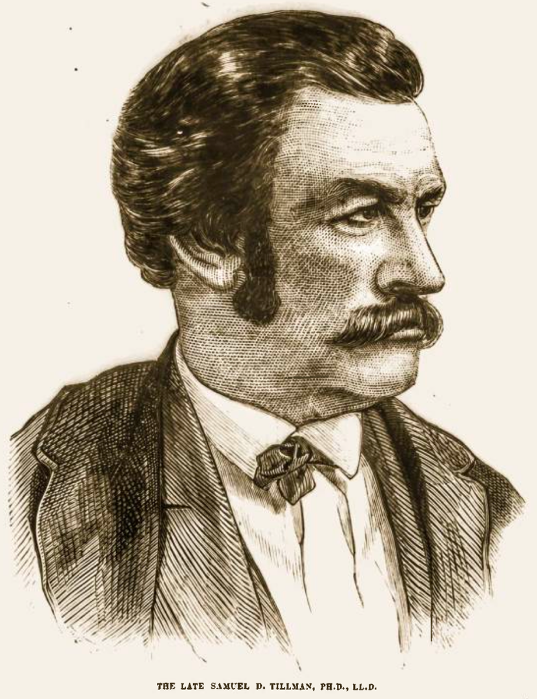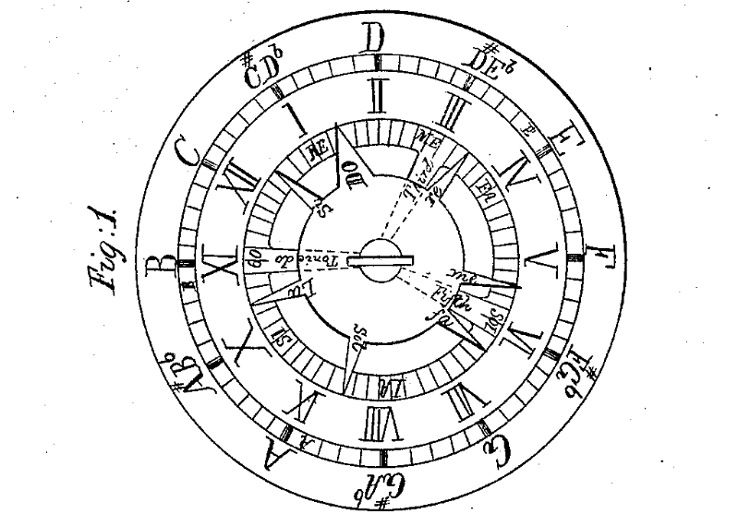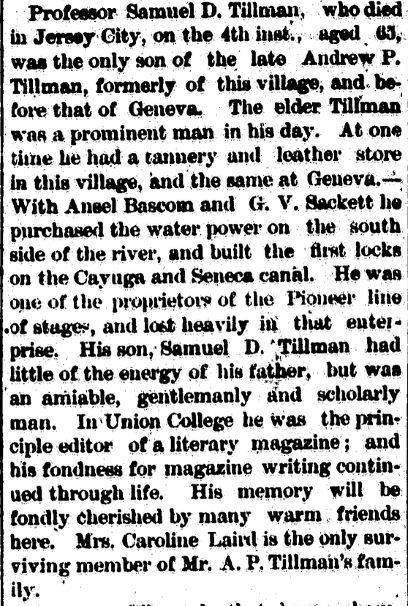Signer #70, Samuel D. Tillman: "The Little Secret"
Signer #70: Samuel Dyer Tillman, PhD, LLD
Born: April 1, 1813 or 1815, Utica, Oneida County, New York
Died: September 4, 1875, Jersey City, New Jersey, age 60 or 62
Occupations: Lawyer, Inventor, Scientist, Professor, Politician, Composer
Local Residence(s): Exchange Street, Geneva, Ontario County; Seneca Falls

A trace of signer #70 popped up unexpectedly during the search for William Burroughs, Signer #82. Like Burroughs, Samuel D. Tillman is listed as a Seneca County attorney in Livingston's Law Register during the early 1850s. In spite of his humble beginnings as a country lawyer, Tillman would go on to receive a great deal of notoriety after turning 40. He would eventually earn a reputation as a multi-talented inventor and scholar, securing patents for a slew of inventions. He gained entrée into the upper-crust of New York's intelligentsia, rubbing elbows with the notable and elite. He married the scion of a well-to-do family that lent its name to a prominent brand, which remains supremely recognizable to this day. For all of these accomplishments, Samuel Tillman has a massive archival footprint. Much of the work for this profile involved connecting the story of his activist youth with the celebrity he attained later in life.

For all the renown that Samuel Tillman ultimately achieved, he never publicly embraced his involvement in the Seneca Falls Convention. After completely reinventing himself as a polymath and man of science, he took no credit for being the second male signer of the Declaration of Sentiments. And he never expressed any sympathy for the Suffrage Movement. The story of Signer #70 is somewhat reminiscent of fellow New Yorker Harriet Cady Eaton, Signer #2, who allegedly requested that her name be redacted from the Declaration shortly after signing it. Eaton did so despite being the sister of Elizabeth Cady Stanton. For Samuel Tillman, what happened at Seneca Falls would have to remain a youthful indiscretion. It would be his little secret.
In a piece first published in 1903, Seneca Falls resident Adeline Cowing provides a short history of the Tillman family. Samuel's father, Andrew Powers Tillman, relocated to Geneva from Utica some time after 1813. With business partner Ansel Bascom, Andrew won a contract to build the first system of canal locks in the vicinity of Seneca Falls and Waterloo. Andrew Tillman made a small fortune in the coming decades through this enterprise and by operating sawmills, leather tanneries, and a stage coach line. He also acquired real estate around the canal system and constructed several homes in the area (72).
The son of Sarah Nichols Dyer and Andrew Tillman, Samuel Tillman's birthplace is consistently given as Utica (“Sarah Tillman”). I take this to mean that Andrew Tillman first relocated to the Finger Lakes Region alone, and his wife and children joined him some time thereafter.
At age 16, Samuel enrolled at Union College, located in Schenectady. While at school, he helped to establish a student literary journal called Parthenon. Writing in 1846, Samuel remembered that the opportunity arose when the semester was abruptly cancelled because of an outbreak of disease. The college “closed suddenly on account of the cholera, which was then carrying off its victims daily all about us,” giving him time to start work on the magazine (“Founding” 12). Samuel graduated in 1834 and continued on to study law in Canandaigua, Ontario County. He was admitted to the New York Bar in 1840 (Cowing 72).
After practicing law briefly in Canandaigua, Samuel moved back to Seneca Falls some time before 1842 (“Late Prof”). There, he founded a law firm with his father's former business partner, Ansel Bascom, who would go on to play an active role in the Seneca Falls Convention. Bascom and Tillman's office was located on Bayard Street near the Seneca Hotel (Cowing 72).
During the 1840s, Samuel became active in a variety of progressive causes. This included Temperance, where he had a chance to showcase his lifelong love of music. For one event, he composed “several odes,” extolling the virtues of teetotaling and decrying “the tyranny of the rum-power." These pieces were performed at a local Baptist church on July 4, 1842 (Chamberlain 2). For another rally on July 8, 1852, Samuel gave an oration on behalf of temperance and led one of many non-alcoholic toasts (“Old”).
Regarding his political affiliations in this period, Samuel is recorded chairing an 1839 convention of young Whigs, assembled in Auburn (“Whig”). In 1844, Samuel accompanied Dexter Bloomer, the spouse of Amelia Bloomer, as the Seneca Falls delegates to a nominating committee convened in Utica to support the presidential candidacy of Whig Henry Clay (“County Central”). By the end of the 1840s, Samuel affiliated, like many signers, with the Free Soil Movement (Wellman 208). Regarding his engagement at the Seneca Falls Convention in July 1848, Samuel, then 33 or 35, is said to have “read aloud statutes which illustrated women’s status in the law,” an action reflecting the specific interest lawyers took in the legal aspects of the proceedings (Brown 63).
By the 1850 census for Seneca Falls, Samuel is 37 and a lawyer. He resides with his father, Andrew, 64, a tanner and currier, who has amassed assets worth $25,000 dollars. Samuel's mother and a sister, Louisa, had both passed away in 1840 ("Louisa Tillman"). 
Another cause Samuel Tillman espoused in this period involved the reform of higher education. A body called the People's College Association convened in Seneca Falls in October 1852. It advocated for the adoption of collegiate curricula centered around the study of “the Physical Laws by which the universe is governed” and “the best practical application of those laws to the work of the artisan and agriculturist.” This would require abandoning “the study of Dead Languages” (“Seneca Falls”). Samuel chaired the meeting, at which Ansel Bascom and Susan B. Anthony were present and participated.
Samuel also held political office in the first half of the 1850s. In 1851, he served as inspector and clerk of elections (“Town”). He served president of Seneca Falls in 1852 (Brigham 20). He had also begun to pursue a passion for invention. In 1844, he had patented a modified version of a thermostat intended for use on stoves (Keller 419). His invention of this apparatus is in keeping with a local fascination with thermodynamics, as embodied in the research of Eunice Newton Foote, Signer #5. In April 1853, Samuel was awarded the patent for a stove radiator. In November of the same year, he patented a revolving musical scale for “Measuring and Illustrating Musical Intervals.” The illustration that accompanies the patent application shows a series of rotating dials to be used as a chart:

Samuel Tillman appears as a Seneca Falls lawyer in Livingston's Law Register one final time in 1856 (197). Thereafter, he successfully and entirely transformed himself, transitioning to New York City in pursuit of a new career and life. As Frank Leslie's Newspaper later describes it, “he abandoned the practice of his profession, which had always been subordinate to his love of literature and natural aptitude for mechanics and scientific investigations” (45).
His abilities swiftly received some attention. Samuel found employment as a professor of science and mechanics at the American Institute of the City of New York for the Encouragement of Science and Invention. With membership that included luminaries such as Joseph Henry and Horace Greeley, the organization was not so much dedicated to the education of a student body. Rather, it more closely resembled an academic society or advocacy group dedicated to exploring recent scientific innovations and publicizing new breakthroughs to the public. In his capacity at the American Institute, Samuel served as corresponding secretary, where he edited and oversaw the group's publications. He would also become active in the American Association for the Advancement of Science, which survives today.
Samuel's own scholarly contributions to the American Institute appear peppered throughout the society's transactions. His investigations touched upon a variety of topics, including the study of music and acoustics. Possibly bearing the influence of his father, Samuel discoursed upon topics related to transportation, such as the maintenance and optimization of roads and canals. He even "propounded a new Theory of Atoms, which has received the highest commendations from the savans of this country and Europe" (Leslie 45). This took the form of a new field of science that studied molecular vibrations, which Samuel dubbed "Clydonics."
In 1866, Samuel published a pamphlet entitled A New Chemical Nomenclature, which proposed a simplified system for naming chemical compounds. He hoped this would help to eliminate chemistry's antiquated terminology and reduce confusion for students. At some point, it appears that Samuel received criticism that his new nomenclature was derivative or borrowed too heavily from others' recent work. Countering these claims, Samuel argued that he had originally devised the system in 1845. In an 1868 paper given before the American Institute, he cites, "Mrs. Elizabeth Cady Stanton, the distinguished philanthropist," who "remembers my explanation of it to her in the year 1846” (1017). This passing reference to Signer #4 is the closest Samuel Tillman ever placed himself to Seneca Falls or to the Suffrage Movement.
Samuel married Frances “Fannie” Dixon on March 2, 1869, in a wedding officiated by Henry Ward Beecher, the famed minister and sibling of Harriet Beecher Stowe (Barber 72). Fannie was the daughter of Joseph Dixon, the founder of what would become known as the Dixon Ticonderoga Company (Cowing 72). The Joseph Dixon Crucible Company, as it was then known, had its headquarters in Jersey City, New Jersey. At the time, it produced a range of graphite products other than pencils, including stove polish and crucibles for smelting metal. Joseph Dixon was a member of the American Institute, and he and Samuel had previously sat together on one of its subcommittees (Annual Report iv). Dixon passed away in June 1869, shortly after his daughter's marriage ("Joseph Dixon"). In the decade after its founder's death, Dixon Crucible would acquire the American Graphite Company, located in Ticonderoga, New York, and shift operations more fully to the mass production of pencils (“Dixon Ticonderoga”).
The 1870 census for Jersey City finds Samuel, 56 and a lawyer, residing in the household of Hannah Dixon, 75. Joseph’s widow, Hannah maintains an estate worth $46,000. They live with Fannie, 41, as well as two servants and a coachman. An 1869 directory for Jersey City gives Samuel’s occupation as professor, and his residence is listed as the Dixon household at 148 Barrow Street (360).

Marrying into wealth evidently gave Samuel the time and freedom to focus more attentively on his creations. As one account explains, referring to Fannie, “The worthy lady who had given him her hand bestowed with it an ample fortune, which enabled him to carry out many of his scientific ideas” (“Professor” 73). During the next half decade, Samuel secured a series of new patents. In June 1870, he patented three inventions: a design for iron pavement tile to be used on roadways, a steam heater for stoves, and a modified propeller system for watercraft.
In July 1872, he was awarded two more patents. The first was for an apparatus that calculated latitude and longitude, and the second entailed a new improvement in reciprocating engines.

The next, secured in December 1873, consisted of a new type of tile plating to be used in tramways.

In March 1874, he patented a new, elaborated version of the device that indicated musical intervals. Union College, Samuel's alma mater, recognized his dedication to science and invention by granting him an honorary doctorate in 1875 (Appleton’s 119).
Samuel Dyer Tillman died in Jersey City on September 4, 1875. A death index identifies the cause as Brights Disease, an ailment of the kidneys. Samuel is interred at the Dixon family plot in Brooklyn's Green-Wood Cemetery, the same location where Eunice Newton Foote and Elisha Foote (#72) are buried (“Samuel D. Tillman”).
An obituary that ran in Popular Science praised Samuel for the fact that he “was familiar with almost every department of science, and, in addition, possessed a great fund of general knowledge” (255). The Waterloo Observer states, oddly, that Samuel paled in comparison to his father, Andrew Tillman. The son had “little of the energy of his father, but was an amiable gentlemanly and scholarly man” (“Seneca Falls”).
 Obituaries also appeared in neighboring Geneva and Watkins (“Neighboring”). Frank Leslie’s Illustrated Newspaper published a full-page memorial recognizing Samuel’s achievements, stating “Professor Tillman was remarkable for his geniality and almost feminine gentleness of nature and manner” (45). The Phrenological Journal, dedicated to the pseudoscientific study of head-shape as a marker of intelligence, also ran an obituary. Samuel had published his speculations on the atom in that periodical in 1872.
Obituaries also appeared in neighboring Geneva and Watkins (“Neighboring”). Frank Leslie’s Illustrated Newspaper published a full-page memorial recognizing Samuel’s achievements, stating “Professor Tillman was remarkable for his geniality and almost feminine gentleness of nature and manner” (45). The Phrenological Journal, dedicated to the pseudoscientific study of head-shape as a marker of intelligence, also ran an obituary. Samuel had published his speculations on the atom in that periodical in 1872.
The New York Historical Society has two portraits of Samuel, including an oil painting by Thomas Hicks.

Samuel's wife, Frances Dixon Tillman, would return to Massachusetts, passing away in Marblehead in October 1903 ("Frances Tillman").
Practically none of the obituaries of the 100 signers mention their involvement at the Seneca Falls Convention, offering some intimation that the deceased was present at this crucial event in American history. The second male signatory, Samuel D. Tillman achieved fame as a versatile, gifted intellect. Beyond a brief mention of “philanthropist” Elizabeth Cady Stanton, he never used the platform that came with celebrity to re-acknowledge the radical politics of his youth. It is conceivable that Samuel's little secret would not have sat well among the polite, nouveau riche society of Gilded Age New York. To this politically traditional, patriarchal world, Samuel Tillman's associations with the Seneca Falls Convention might well have served as a mark against him.
Works Cited
Annual Report of the American Institute of the City of New York. Wendell, 1865.
Barber, Gertrude. Marriages Taken from the New York Evening Post. 1938.
Brigham, DeLancey. Brigham’s Geneva, Seneca Falls, and Waterloo Directory and Business Advertiser, For 1862 and 1863. 1862.
Brown, Sharon A. Historic Structure Report: Historical Data Section, Wesleyan Chapel, Women’s Rights National Historical Park, New York. U.S. Department of the Interior, National Park Service, 1987.
Catalogue of American Portraits in The New-York Historical Society. New York Historical Society, 1941.
Chamberlain, Harrison. “The Seneca Falls Press.” Seneca County Courier-Journal, 16 Nov. 1905, pp. 1-2.
“County Central Clay Committee.” Utica Daily Gazette, 7 June 1844, p. 1.
Cowing, Adeline. “The Tillman Family.” Papers Read Before the Seneca Falls Historical Society For the Year 1913. Seneca Falls Historical Society, 1913, pp. 72-3.
“Died.” Popular Science, Dec. 1875, p. 255.
"Dixon Household.” Federal Census, 1870. Jersey City, Hudson County, New Jersey. Ancestry.com, Accessed 25 May 2024.
“Dixon Ticonderoga Company.” Encyclopedia.com, Accessed 11 June 2024.
“Frances Tillman—Deaths Registered in Marblehead.” Massachusetts Birth, Marriage, and Death Records, 1875. Ancestry.com. Accessed 11 June 2024.
Gopsill, James and Isaac Costa. Gopsill’s Jersey City & Hoboken Directory. Lyon, 1869.
"Joseph Dixon." Findagrave.com, Accessed 11 June 2024. https://www.findagrave.com/memorial/58105203/joseph-dixon.
Keller, Charles. “American Patents.” Journal of the Franklin Institute, vol. 38, Dec. 1844, pp. 408-429.
“The Late Prof. Samuel D. Tillman.” Frank Leslie’s Illustrated Newspaper, 25 Sept. 1875, p. 45.
Livingston, John. Livingston’s Law Register for 1853. Office of the Law Magazine, 1853.
---. Livingston’s Law Register for 1856. Self-published, 1856.
"Louisa Tillman." Findagrave.com, Accessed 11 June 2024. https://www.findagrave.com/memorial/117596719/louisa_gertrude_tillman.
“Neighboring Counties.” Watkins Express, 16 Sep. 1875, p. 1.
“An Old Time Fourth of July Celebration in Seneca Falls.” Seneca County Courier-Journal, 27 July, 1905, p. 1.
Proceedings of the American Association for the Advancement of Science, Nineteenth Meeting Held at Troy, New York, August 1870. Lovering, 1871.
“Professor Samuel D. Tillman.” The Phrenological Journal and Life Illustrated, January 1876, pp. 72-3.
“Samuel D. Tillman—Return of Deaths, Jersey City.” New Jersey Birth, Marriage, and Death Records, 1875. Ancestry.com, Accessed 11 June 2024.
“Samuel D. Tillman.” Findagrave.com, Accessed 11 June 2024. https://www.findagrave.com/memorial/57430961/samuel_dyer-tillman.
“Samuel Dyer Tillman.” Appleton's Cyclopaedia of American Biography, volume 6, 1889.
“Sarah Nichols Dyer Tillman.” Findagrave.com, Accessed 11 June 2024. https://www.findagrave.com/memorial/117596718/sarah_nichols-tillman.
“Seneca Falls Items.” Waterloo Observer, 15 Sep. 1875, p. 1.
"Tillman Household.” Federal Census, 1850. Seneca Falls, Seneca County, New York. Ancestry.com, Accessed 25 May 2024.
Tillman, Samuel D. “Patent Application: Radiator for Stoves.” Patent US9690A, 26 April 1853.
---. “Patent Application: Revolving Musical Scales.” Patent US10217A, 8 Nov. 1853.
---. A New Chemical Nomenclature. Van Benthuysen, 1866.
---. “The New Chemical Nomenclature.” Annual Report of the American Institute, of the City of New York for the Year 1867-8. Van Benthuysen, 1868. pp. 1013-1019.
---. “Patent Application: Improvement in Metallic Pavements.” Patent US104513A, 21 June 1870.
---. “Patent Application: Steam Heater.” Patent US104510A, 21 June 1870.
---. “Patent Application: Improvement in Propelling Vessels.” Patent US104512A, 21 June 1870.
---. “Patent Application: Improvement in Reciprocating Engines.” Patent US129694A, 23 July 1872.
--. “Patent Application: Apparatus for Showing Latitude, Longitude, and Difference of Time.” Patent US129909A, 30 July 1872.
---. "Atoms and Molecules." American Phrenological Journal and Life Illustrated, Sept. 1872, pp. 203-208.
---. “Patent Application: Plates for Tramways.” Patent US146033A, 30 Dec. 1873.
---. “Patent Application: Apparatus for Showing Latitude, Longitude, and Difference of Time.” Patent US148097A, 3 March 1874.
---. “The Founding of the ‘Parthenon.’” The Concordiensis, Mar. 1908, pp. 12-13.
“Seneca Falls, Oct. 14, 1852.” The Elmira Daily Republican, 14 Oct. 1852, p. 1.
“Town of Seneca Falls.” The Ovid Bee, 15 Jan. 1851, p. 1.
Wellman, Judith. The Road to Seneca Falls: Elizabeth Cady Stanton and the First Woman’s Rights Convention. University of Illinois Press, 2010.
“Whig Young Men’s Senatorial Convention.” Cortland and Homer Republican and Eagle, 23 Sep. 1839, p. 1.